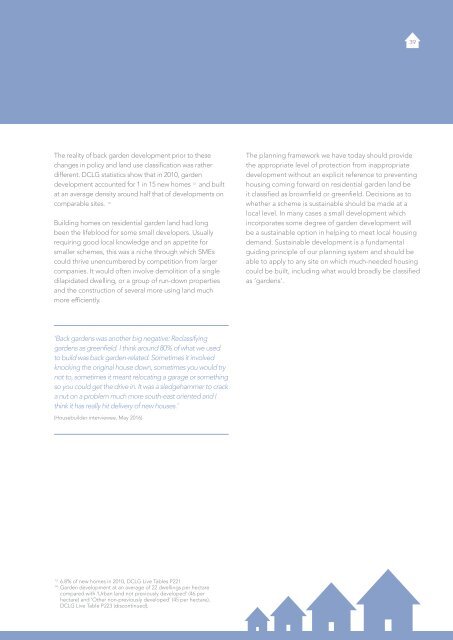Reversing the decline of small housebuilders
HBF_SME_Report_2017_Web
HBF_SME_Report_2017_Web
You also want an ePaper? Increase the reach of your titles
YUMPU automatically turns print PDFs into web optimized ePapers that Google loves.
39<br />
The reality <strong>of</strong> back garden development prior to <strong>the</strong>se<br />
changes in policy and land use classification was ra<strong>the</strong>r<br />
different. DCLG statistics show that in 2010, garden<br />
development accounted for 1 in 15 new homes 13 and built<br />
at an average density around half that <strong>of</strong> developments on<br />
comparable sites.<br />
14<br />
Building homes on residential garden land had long<br />
been <strong>the</strong> lifeblood for some <strong>small</strong> developers. Usually<br />
requiring good local knowledge and an appetite for<br />
<strong>small</strong>er schemes, this was a niche through which SMEs<br />
could thrive unencumbered by competition from larger<br />
companies. It would <strong>of</strong>ten involve demolition <strong>of</strong> a single<br />
dilapidated dwelling, or a group <strong>of</strong> run-down properties<br />
and <strong>the</strong> construction <strong>of</strong> several more using land much<br />
more efficiently.<br />
The planning framework we have today should provide<br />
<strong>the</strong> appropriate level <strong>of</strong> protection from inappropriate<br />
development without an explicit reference to preventing<br />
housing coming forward on residential garden land be<br />
it classified as brownfield or greenfield. Decisions as to<br />
whe<strong>the</strong>r a scheme is sustainable should be made at a<br />
local level. In many cases a <strong>small</strong> development which<br />
incorporates some degree <strong>of</strong> garden development will<br />
be a sustainable option in helping to meet local housing<br />
demand. Sustainable development is a fundamental<br />
guiding principle <strong>of</strong> our planning system and should be<br />
able to apply to any site on which much-needed housing<br />
could be built, including what would broadly be classified<br />
as ‘gardens’.<br />
‘Back gardens was ano<strong>the</strong>r big negative: Reclassifying<br />
gardens as greenfield. I think around 80% <strong>of</strong> what we used<br />
to build was back garden-related. Sometimes it involved<br />
knocking <strong>the</strong> original house down, sometimes you would try<br />
not to, sometimes it meant relocating a garage or something<br />
so you could get <strong>the</strong> drive in. It was a sledgehammer to crack<br />
a nut on a problem much more south-east oriented and I<br />
think it has really hit delivery <strong>of</strong> new houses.’<br />
(Housebuilder interviewee, May 2016)<br />
13<br />
6.8% <strong>of</strong> new homes in 2010, DCLG Live Tables P221<br />
14 <br />
Garden development at an average <strong>of</strong> 22 dwellings per hectare<br />
compared with ‘Urban land not previously developed’ (46 per<br />
hectare) and ‘O<strong>the</strong>r non-previously developed’ (45 per hectare),<br />
DCLG Live Table P223 (discontinued).


